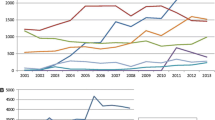Abstract
The direct reporting of adverse drug reactions by patients is becoming an increasingly important topic for discussion in the world of pharmacovigilance. At this time, few countries accept consumer reports.
We present an overview of experiences with consumer reporting in various countries of the world. The potential contribution of patient reports of adverse drug reactions is discussed, both in terms of their qualitative and quantitative contribution. The crucial question is one of whether patient reports will increase the number and quality of the reports submitted and/or lead to a more timely detection of signals of possible adverse reactions, thus contributing to an enhancement of the existing methods of drug safety monitoring. To date, the data available are insufficient to establish such added value.
Similar content being viewed by others
References
International Society of Drug Bulletins (ISDB). Declaration on therapeutic advance in the use of medicines. ISDB, Paris 2001
van den Bemt PMLA, Egberts ACG, Lendering AW, et al. Adverse drug events in hospitalized patients: a comparison of doctors, nurses and patients as sources of reports. Eur J Clin Pharmacol 1999; 55: 155–8
Jarernsiripornkul N, Krska J, Capps PAG, et al. Patient reporting of potential adverse drug reactions: a methodological study. Br J Clin Pharmacol 2002; 53: 318–25
Mitchell AS, Henry DA, Sanson-Fischer R, et al. Patients as a direct source of information on adverse drug reactions. BMJ 1988; 297: 891–3
Solovitch BL, Fisher S, Bryand SG, et al. How well can patients discriminate drug-related side effects from extraneous new symptoms? Psychopharmacol Bull 1987; 23: 189–92
Egberts ACG, Smulders M, de Koning GHP, et al. Can adverse drug reactions be detected earlier? A comparison of reports by patients and professionals. BMJ 1996; 313: 530–1
Egberts ACG, Koning FHP de, Meyboom RHB, et al. ADR-related questions received by a telephone medicine information service and ADRs received by a spontaneous ADR reporting system: a comparison regarding patients and drug. Pharmacoepidemiol Drug Saf 1997; 6: 269–76
Routledge P. 150 years of pharmacovigilance. Lancet 1998; 351: 1200–1
Dukes MNG, Aronsons JK, editors. Meyler’s side effects of drugs. 14th ed. Amsterdam: Elsevier, 2001
Procedure for competent authorities on the undertaking of pharmacovigilance activities. In: The rules governing medicinal products in the European Union. Vol. 9: 61–77 [online]. Available from URL: http://www.pharmacos.eudra.org/F2/home.html [Accessed 2003 Feb 12]
van Grootheest AC, van Puijenbroek EP, Jong-van den Berg LTW. Contribution of pharmacists to the reporting of adverse drug reactions. Pharmacoepidemiol Drug Saf 2002; 11: 205–10
Annual Adverse Drug Experience Report: 1997. FDA 1997 [online]. Available from URL: http://www.fda.gov/cder/dpe/annrep96 [Accessed 2003 Feb 13]
Roughead L. Consumer reporting of adverse drug events: a discussion paper for the consumer reporting of adverse drug events working party of the Australian Pharmaceutical Advisory Council. Paper Kilen Conference; Sigtuna, 2000
Direct Reporting by Consumers - First International Conference. WHO Pharmaceutical Newsletters [online]. Available from URL: http://www.fda.gov/medwatch/safety/ar95.pdf [Accessed 2003 Feb 12]
Wouterse JJ. Patiëntenervaringen, een bron van informatie rijker Wetenschapswinkel Geneesmiddelen, Faculteit Farmacie, Universiteit Utrecht. 1998 Mei
UK call for patient ADR reporting. Script 2001; 2634: 4
Mayor S. NHS introduces new patient safety agency. BMJ 2001; 322: 1013
Sukker E, UK patients to report ADRs [comment]. Script 2002; 2784: 5
Morel P, Vandel B. Adverse drug reaction monitoring and the Internet: evaluation of the use of the Internet by French Pharmacovigilance Centres and a non-exhaustive survey of websites of interest for collecting information about adverse drug reactions. Thérapie 1999; 54: 525–32
Rijcken CAW, Dekens-Konter JAM, Knegtering H, et al. Reporting sexual function disorders caused by antipsychotic drugs: is there a role for the pharmacy? Pharm World Sci 2001; 23: 169–72
Edwards IR. Spontaneous reporting: of what? Clinical concerns about drugs. Br J Clin Pharmacol 1999; 48: 138–41
Eland IA, Belton KJ, van Grootheest AC, et al. Attitudinal survey of voluntary reporting of adverse drug reactions. Br J Clin Pharmacol 1999; 48: 623–7
Watson R. Consumer groups fight plans for ‘direct to patient’ drug advertisements. BMJ 2001; 323: 889
Drazen JM. The consumer and the learned intermediary in health care. N Engl J Med 2002; 346: 523–3
Fleuranceau-Morel P. How do pharmaceutical companies handle consumer adverse drug reactions reports? An overview based on a survey of French drug safety managers and officers. Pharmacoepidemiol Drug Saf 2002; 11: 37–44
Acknowledgments
No sources of funding were used to assist in the preparation of this manuscript. The authors have no potential conflicts of interest that are directly relevant to the contents of this manuscript.
Author information
Authors and Affiliations
Corresponding author
Rights and permissions
About this article
Cite this article
van Grootheest, K., de Graaf, L. & de Jong-van den Berg, L.T. Consumer Adverse Drug Reaction Reporting. Drug-Safety 26, 211–217 (2003). https://doi.org/10.2165/00002018-200326040-00001
Published:
Issue Date:
DOI: https://doi.org/10.2165/00002018-200326040-00001



